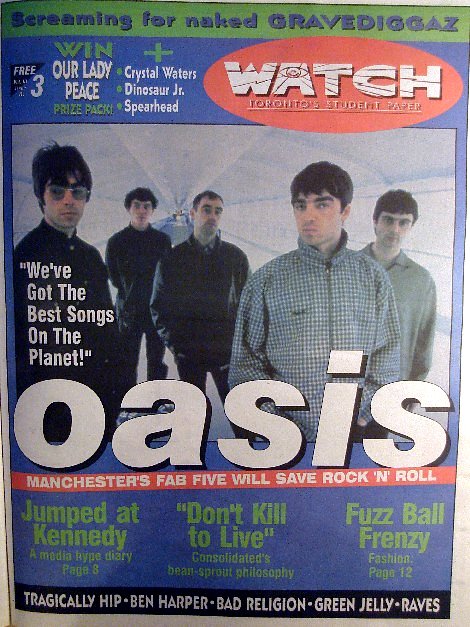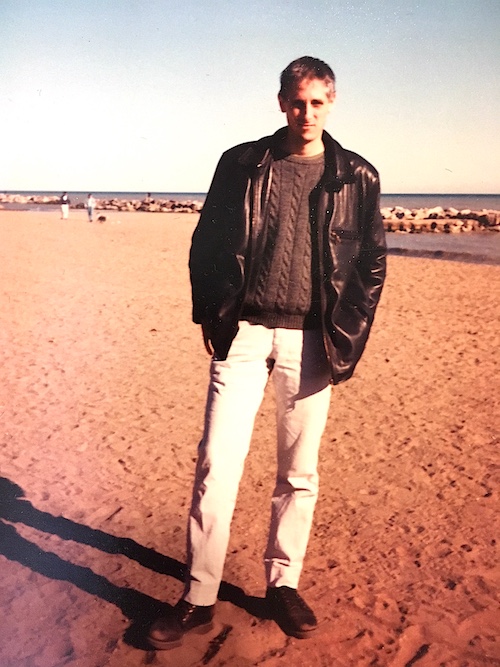“I got laid off too many times. Now, I work harder for less money. But I get to do what I want to do. Not many people get that.”
By David South
Id Magazine (Canada), February 6 to 19, 1997
The little tiger-striped four-by-four is definitely going too fast. In an instant, the diminutive Suzuki stands balanced, its front wheels squashed at 90 degrees. A millisecond later, it’s on its back like a ladybug flipped over by the wind. The cacophony of the crowd reaches a crescendo. But the noise had been building; the Skydome crowd saw the writing on the wall for the little jeep.
Frantic helpers pry open the door of the jeep, wrestling free the driver, Dwayne Robichaud. He emerges in an orange jump suit and prances around, looking vaguely like the Oklahoma bomber. The audience lets out an even louder cheer as he walks away, smug and happy.
Half an hour earlier, two monster trucks, Young Gun and Samson, line up behind a pile of crushed cars, with a dirt ramp at each end. The methanol engines let out a roar like the mother of all hairdryers. The revving turns into a drag race. The pulsating white noise rattles the cavernous Dome. The effect on the audience is almost sexual: the stomach rattles, the heart skips a few beats. It is a short buzz, but it is good. And the noise? I begin to notice that everyone around me has ear plugs and I realize I’m going to regret this in 20 years.
The exhaust fumes are starting to reach toxic levels 40 minutes into the rally. I shake my head and feel the motion a few seconds later. I’m getting a CO2 buzz, too. It’s the USA Motor Spectacular monster truck derby at Toronto’s Skydome. But monster trucks are just a small part of the show, there for the crowd to ogle while they get off on the noise. There is the amateur truck rally involving the tippy Suzuki and other monster-truck wannabees, and a ridiculous car-eating, fire-breathing robot called Robosaurus for the kids. The metal bashing of the demolition derby serves to satiate the audience’s thirst for damage – and is truly the highlight of the night.
I can’t get out of my mind comparisons to spectacles in Roman times. Titans of spectacle, the Romans set the benchmark by which all other public entertainment must be judged. On the spectacular scale, Roman bloodsports involving gladiators, wild animals and the sacrificing of Christians definitely rate a 10 – anything else falls below. I figure monster trucks rate about 4. Watching pick-up trucks with over-sized $10,000 tractor tires crush cars can’t match the gore and death of ancient Rome but it will do for now.
If monster trucks join professional wrestling and American Gladators as today’s answer to blood sports, why does this spectacle seem to lack that je ne sais quoi? Maybe it’s the sanitization of risk. The cabin of a monster truck coddles the driver. There are cushioned seats, a kidney brace, a five-point racing harness, neck braces, helmet restraints and a roll bar. Several drivers tell me that the job only looks dangerous. At half time, Young Gun’s Saskatoon-based driver, Kevin Weenks, tells me he doesn’t seek out danger. “I think some of those (amateur) guys are nuts and want to do the crowd a big favour [die]. You don’t want to run it hard. A win isn’t worth flipping over.”
Derby destruction
Thirty demolition derby wrecks crawl into the centre of the Skydome. The flag is dropped and an orgy of car crushing begins. It goes on for half an hour. Now I’m not bored. Cars are still driving despite engine fires and rear-ends that stand at 45 degrees. It is down to two cars: one more or less intact, the other driving on its hubs, engine on fire, half its back a mangled piece of crumpled paper. The driver doesn’t give up. His engine stops, then starts again. This is repeated three times until, exhausted, he concedes defeat.
After the derby it’s time for Robosaurus. The press release claims the hunk of grey metal stands five stories tall and costs $2.1 million. The driver flicks on the switch on a very expensive stereo system and Robosaurus starts to growl like Godzilla. Two guys with radio headsets help direct the beast onto the floor. It burps and farts for a while before picking up a pre-cut car. It crushes it, drops it to the floor and incinerates it with a flame thrower. The crowd roars.
It seems things haven’t changed with spectacles. The Romans drew on slaves, freed men, foreigners and the lower social orders to provide fodder for their spectacles. Monster trucks are driven by farmers hired for six months at a time. The amateur drivers are a hodgepodge of laid-off workers, farm labourers and guys who make a meagre living fixing four-by-fours.
Wearing a waist-length monogrammed racing jacket is Don Frankish. The shy and patient Alberta grain farmer owns two of the four monster trucks in Canada. He has been racing for seven years and divides his year 50/50 between farming and tours on the monster truck circuit, which mostly takes him through the U.S.
He is definitely attracted to the excitement of the stadium, but not necessarily a love of death-defying acts. “It’s the rush of the crowd as they get behind you, talking to the kids who look at you as a superhero,” he says. “I like the speed, the unpredictability. We know the risks. There is a danger to it. But the Monster Truck Racing Association makes sure we have a killer radio to shut off the engines if the truck is out of control. The worst I’ve ever seen is a truck going end over end three times – it just destroyed the truck.” I ask him about insurance and he laughs. “We can’t get insurance!”
Pit boys
Down in the pit, the air is thick with exhaust fumes. The pit boys are milling about, patting each other on the back. A sprinkling of pit girls hang around, with hairstyles straight out of Xena: Warrior Princess. The dress for today is black: black t-shirts and black jeans. Don McGuire, 32-year-old partner in the Three Stooges four-by-four shop in Brampton, sports a mischievous grin as he tells me with pride about his chosen vocation: mud bog racing. It’s the messier outdoor version of tonight’s amateur truck rally. McGuire has been a mud bog racer for 10 years and isn’t doing it for the money. “First prize is just $200 – I spring for more money than I would ever win,” he says. “We do this for the pure adrenaline. It’s just heart and soul. It takes bucks per cubic inch to win in this business,” he says resentfully, looking across the Skydome to where the monster trucks are parked. Big Foot’s sponsorship by Ford seems to be a sore point with racers who spend thousands of their own dollars to come here.
McGuire gave up a $700 a week job to earn $300 a week and race. “I got laid off too many times. Now, I work harder for less money. But I get to do what I want to do. Not many people get that.”
“We do this for the pure adrenaline. It’s just heart and soul. It takes bucks per cubic inch to win in this business”






https://davidsouthconsulting.org/2021/07/20/case-study-3-id-magazine-1996-1997-2/
https://davidsouthconsulting.org/2020/11/17/land-of-the-free-home-of-the-bored/
https://davidsouthconsulting.org/2021/01/20/pulling-the-plug-on-hate-rock-1996/
https://davidsouthconsulting.org/2021/02/03/swing-shift-sexual-liberation-is-back-in-style/
https://davidsouthconsulting.org/2020/12/11/tvs-moral-guide-in-question-again/

This work is licensed under a
Creative Commons Attribution-Noncommercial-No Derivative Works 3.0 License.
ORCID iD: https://orcid.org/0000-0001-5311-1052.
© David South Consulting 2023






















You must be logged in to post a comment.